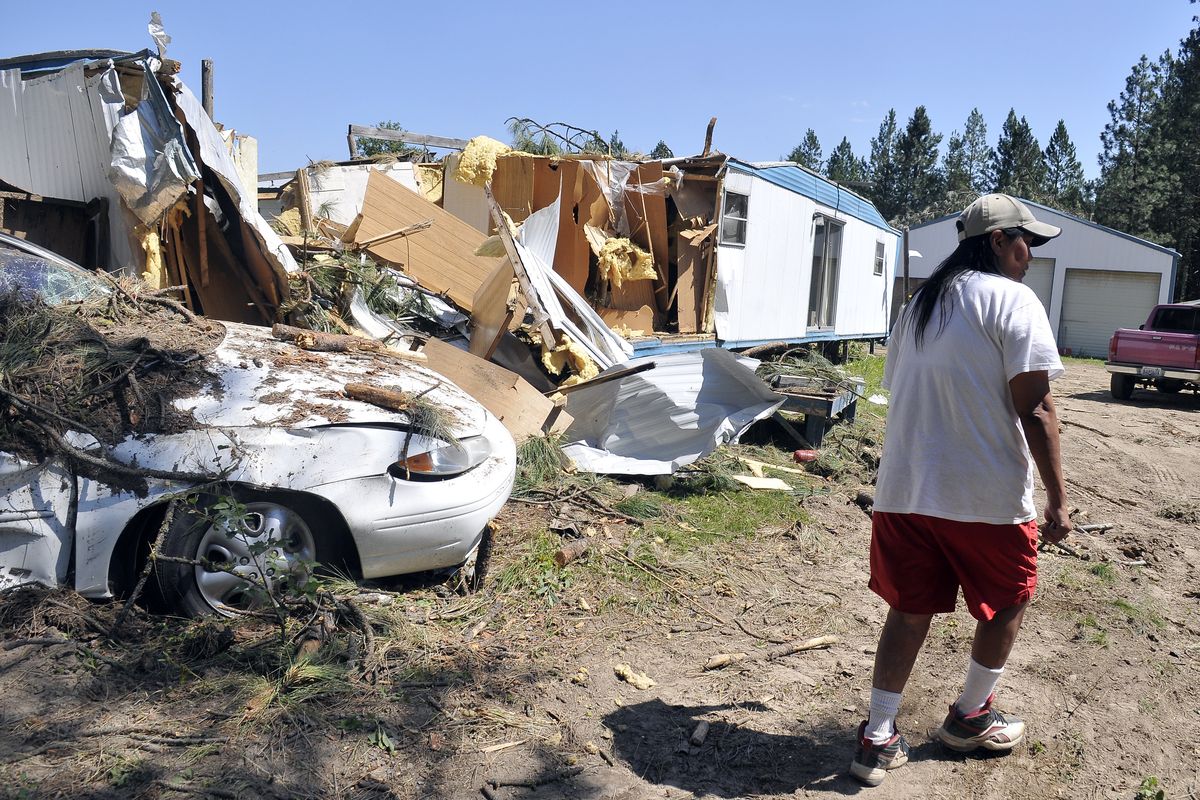Community recuperates after storm

Lurae Kanzleiter still has nightmares about the tree that crashed through her bedroom ceiling in Keller, Wash., nine days ago.
“You could hear the tree going ‘crack, crack, crack,’ ” Kanzleiter said. “Something just told me to get out of that bedroom, and I’m so thankful that we did.”
She and her family escaped just seconds before the massive trunk ripped through their mobile home during a storm July 20 that ravaged the Inland Northwest with thunder, flash floods, hurricane-force winds and hail the size of golf balls. The event marked the peak of a series of storms that began on July 13 and left 16 Eastern Washington counties in a state of emergency.
Some areas reported winds stronger than 85 mph and streets buried under more than a foot of water that accumulated in less than half an hour. The storm left two dead in the region: a man driving a truck at Priest Lake and a woman who had been camping in the mountains near Curlew in Ferry County.
Kanzleiter is one of many throughout the region still struggling to get back on their feet in the wake of the disaster.
The Ferry County Public Utility District estimated that about 90 percent of the county had power back by Friday morning, but officials said the ones still without electricity live farther out, in the least accessible areas.
Tree trunks, limbs and debris have been cleared from the main roads throughout the county. Forest Service roads, however, still need a lot of work.
The storm rendered Kanzleiter’s home condemned, as damage to the wiring turned it into an electrical hazard. Her two dogs and two birds are still living in the undamaged half of the house.
The storm damaged 20 homes and destroyed six in Keller – a small unincorporated community of Colville tribal members in southeastern Ferry County that sits miles apart from its closest neighbors, Coulee Dam to the southwest and Republic to the north.
About 20 homes in the community are still without power.
Since the night of the storm, Kanzleiter has been living in a gym at the Keller Community Center with her husband and three children. About 30 people took shelter there the night after the storm.
The building became the hub for the community’s recovery effort. All but Kanzleiter and her family have moved into local hotels since then.
The tribe is working on finding the family a more private place to stay for a while, tribal spokeswoman Kathy Moses said.
“(We’re) just running into issues with the shortage of housing on the reservation,” Moses said.
Moses was unsure how long the family will have to stay in the community center.
With roads blocked by fallen trees and diminished communications from downed power lines, community members immediately banded together to take care of those with the most urgent needs. Hundreds in the community stepped in to serve food or clear roads of fallen trees.
By Thursday, the shelter continued to serve about 220 people per meal, including residents and workers.
Yancy Epperson, who oversees the cleanup crews in Keller, estimates that about 85 percent of those working on the recovery effort are tribal members.
Epperson has nine crews who have been out clearing logs and branches from roads and homes since the storm hit. The storm gave many in the community a chance to put their logging experience to good use, he said.
“Let’s put them to work (and) put some money in their pockets,” Epperson said. “Some of them have been unemployed for two years.”
Though the major storm is over, many of the trees in Keller still have unseen fractures. As the wind picked up a little Saturday afternoon a new hazard emerged for the cleanup crews, Moses said.
“It started snapping the trees and it sounded like gunshots were going off,” she said. “It’s pretty unsafe out there.”
The state has also set up on the scene to help meet the residents’ basic needs. The Department of Natural Resources brought trailers on Monday equipped with freezers and refrigerators to keep food from spoiling.
Officials have provided a laundry service, portable showers and a hand-washing station next to the community center. They also drive a potable water truck around the reservation every day to assist those who don’t have access to drinkable water.
FEMA officials will survey the county this week to assess who will receive federal assistance. State and local officials will continue door-to-door checks in Republic, while volunteers run a shelter at Republic High School.
The scale of the disaster eclipses any wildfires, ice storms or floods the county has had in recent memory, said Brian Dansel, chairman of the Ferry County Board of Commissioners.
Even so, the community response has kept things together fairly well, officials say.
Priest Lake State Park is also getting back to normal, despite some closed trails and one cabin that remains inaccessible.
The entire staff at the park worked to clean up the damage after the storm. Workers had a lot of help from visitors, as well, said Loni Johnson, park manager.
“The campers were fantastic,” Johnson said. “I just can’t say enough about how accommodating they were.”